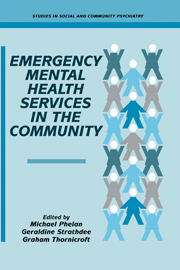Book contents
- Frontmatter
- Contents
- Contributors
- Foreword
- PRINCIPLES AND POLICIES
- 1 The scope and limitations of emergency mental health services in the community
- 2 Service models in emergency psychiatry: an international review
- 3 Users' perspective on emergency needs
- 4 Legal aspects of mental health emergencise
- 5 The economics of mental health emergency services
- 6 Suicide prevention
- 7 Using the crisis
- 8 Community assessment of crisis
- CHALLENGE OF IMPLEMENTATION
- Index
2 - Service models in emergency psychiatry: an international review
from PRINCIPLES AND POLICIES
Published online by Cambridge University Press: 28 October 2009
- Frontmatter
- Contents
- Contributors
- Foreword
- PRINCIPLES AND POLICIES
- 1 The scope and limitations of emergency mental health services in the community
- 2 Service models in emergency psychiatry: an international review
- 3 Users' perspective on emergency needs
- 4 Legal aspects of mental health emergencise
- 5 The economics of mental health emergency services
- 6 Suicide prevention
- 7 Using the crisis
- 8 Community assessment of crisis
- CHALLENGE OF IMPLEMENTATION
- Index
Summary
Introduction
Services for the assessment and management of psychiatric emergencies have been of central importance during deinstitutionalisation and the continuing development of community care. However, discussion and evaluation of this aspect of care have lagged behind that of rehabilitation. The literature in this area is limited and mainly consists of descriptions and, more rarely, evaluations of small model services. There are few general surveys of services for psychiatric emergency care, and very few evaluative studies have taken place outside small experimental services. However, by summarising the various contributions which have been made in this chapter, we aim to construct a general overview of the range of service models, many of which are discussed in more detail in subsequent chapters.
Before reviewing this area, it is important to address the question: what counts as a ‘real’ psychiatric emergency? In particular, should psychosocial crises be distinguished from deteriorations in mental state in those whom psychiatrists would regard as severely mentally ill? In practice, services vary greatly in what they regard as ‘real’ psychiatric emergencies, and consequently in the situations they regard as proper priorities for their interventions. In this review we have included services which serve each of these patient groups. Our discussion is, however, confined to research about those emergency services which, if not based on a purely ‘medical model’, do involve participation by psychiatrists.
There are two main paths along which emergency services may develop (Katschnig & Konieczna, 1990).
- Type
- Chapter
- Information
- Emergency Mental Health Services in the Community , pp. 16 - 38Publisher: Cambridge University PressPrint publication year: 1995
- 1
- Cited by



